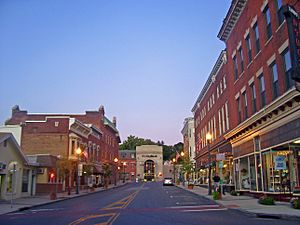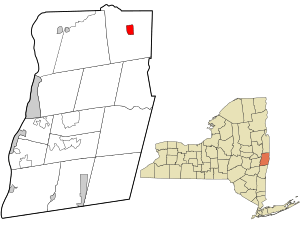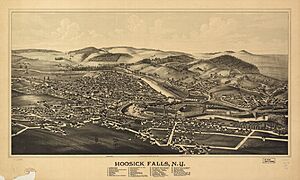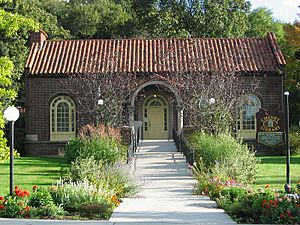Hoosick Falls, New York facts for kids
Quick facts for kids
Hoosick Falls
|
|
|---|---|

Downtown Hoosick Falls
|
|
| Etymology: Falls on adjacent river | |

Location in Rensselaer County and the state of New York.
|
|
| Country | United States |
| State | New York |
| County | Rensselaer |
| Founded | 1827 |
| Area | |
| • Total | 1.60 sq mi (4.14 km2) |
| • Land | 1.60 sq mi (4.14 km2) |
| • Water | 0.00 sq mi (0.00 km2) |
| Elevation | 443 ft (135 m) |
| Highest elevation
(SE corner of village)
|
760 ft (230 m) |
| Lowest elevation
(Hoosick River at N boundary)
|
380 ft (120 m) |
| Population
(2020)
|
|
| • Total | 3,216 |
| • Density | 2,012.52/sq mi (777.04/km2) |
| Time zone | UTC-5 (Eastern (EST)) |
| • Summer (DST) | UTC-4 (EDT) |
| ZIP Code |
12090
|
| Area code(s) | 518 |
| FIPS code | 36-35474 |
| GNIS feature ID | 0953177 |
Hoosick Falls is a small village in Rensselaer County, New York. In 2020, about 3,216 people lived there. Long ago, in 1900, the village was much bigger with around 7,000 residents.
Hoosick Falls is located in the middle of the town of Hoosick, right on NY 22. The main part of the village is a special place called the Hoosick Falls Historic District. Many old buildings from the early 1900s have been fixed up. Today, you can find cool places like a bakery, a French restaurant, a coffee shop, an art gallery, and a barbecue spot with live music.
A famous painter named Grandma Moses is buried in Hoosick Falls. Also nearby is the Bennington Battlefield State Historic Site. This is where an important battle happened on August 6, 1777, during the American Revolutionary War.
Contents
Exploring Hoosick Falls History
People believe the first settlers came to Hoosick Falls, by the Hoosic River, around 1746. The French forced them to leave in 1754 and burned most of the village. But after the French and Indian War ended, the settlers came back and rebuilt. Hoosick Falls officially became a village in 1827.
Walter A. Wood: A Farming Machine Pioneer
In 1852, a blacksmith named Walter A. Wood started making a machine called a reaper in Hoosick Falls. Reapers helped farmers harvest crops much faster. By the 1890s, his company, the Walter A. Wood Mowing & Reaping Company, was the biggest farm machine maker in the world! Their factory covered a huge area of 85 acres.
The Wood Company closed in 1924. This happened partly because new, self-propelled farm equipment from companies like John Deere became popular. Later, other companies used parts of the old factory. Sadly, many of the buildings were destroyed by fires in the 1970s. Today, only a few original buildings remain, like the old office building and a plant that used to be a steel foundry.
During the 1800s, Hoosick Falls was a busy and growing town. Many businesses came, bringing jobs and wealth. The village once had factories that made paper, glass, and even bottled soda and beer. Many beautiful Victorian homes were built then, and most are still standing today. Hoosick Falls was also a hub for trade. Farmers and manufacturers would bring their goods to town to sell or load onto trains. These goods included farm products, building materials like slate and brick, and timber.
Historic Buildings and Landmarks
Several important buildings in Hoosick Falls are listed on the National Register of Historic Places. This means they are special and protected because of their history. These include the Estabrook Octagon House, the Hoosick Falls Armory, St. Mark's Episcopal Church, and the United States Post Office. The entire Hoosick Falls Historic District is also on this list.
The Arts in Hoosick Falls
Hoosick Falls and the area around it have always attracted artists.
- Grandma Moses: This famous American folk artist was born nearby. Her paintings were discovered in a local pharmacy in Hoosick Falls. She is buried in the Maple Grove Cemetery.
- Jose De Creeft: A Spanish sculptor, known for his "Alice in Wonderland" statue in New York City's Central Park, lived in the village. His ashes are buried here.
- Jenny Holzer: An American conceptual artist, she has lived near the village for many years.
- Yucel Erdogan: A New York City artist and photographer, he runs the 3rd Eye Gallery in a renovated building downtown.
Village Murals and Outdoor Art
Hoosick Falls is known for its cool murals and outdoor art. Downtown, you can see two big murals:
- One mural, by local artist Roger Weeden, shows Grandma Moses' painting called "Wagon Repair Shop."
- Another mural, by regional artist Katie May Erskine, shows an owl. This owl represents the original name for the village's location, which meant "The Valley of the Owl" to the native people.
Industry and Manufacturing
Plastics Manufacturing and Water Quality
In 1955, a company called Dodge Fibers Corporation started making products using a material called Teflon in Hoosick Falls. This business grew and was later sold to bigger companies. However, the manufacturing process released a chemical called PFOA into the environment.
In 2014, people in the village became concerned about their water. By December 2015, the village told residents to use bottled water. This water was given for free by Saint-Gobain, the company that now owns the plastics factories.
In 2017, the village built a new water treatment system. This system uses special filters to remove PFOA from the water. Now, all residents get PFOA-free water. In 2021, a plan was announced to build two new water wells for the town. These wells will help make sure the community has a safe and clean water supply for the future.
Understanding the Water Quality Issue
The issue with Hoosick Falls' water was first noticed by a resident named Michael Hickey. He became concerned after his father, who had worked at the Saint-Gobain Performance Plastics plant, passed away from a serious illness. Michael noticed that many people in the village seemed to be getting sick. He started looking into the chemicals used at the local factories.
Over the years, some factories in the area released waste containing PFOA. PFOA is a chemical used to make many everyday products. Studies have shown that PFOA can cause health problems in animals. The Saint-Gobain Performance Plastics factory, which started using PFOA in 1999, is located very close to the village's water treatment plant.
Michael Hickey tested water samples from his home and local businesses. He found high levels of PFOA. At first, the village did not warn residents about the water. But in November 2015, the U.S. Environmental Protection Agency (EPA) advised people not to drink or cook with the public water. In December 2015, the village told residents to use bottled water, which was provided by Saint-Gobain.
In 2016, the Saint-Gobain factory site was added to New York State's list of hazardous waste sites. In 2017, the EPA added it to the Superfund National Priorities List. This list includes sites that need long-term cleanup.
The New York State Department of Environmental Conservation (NYSDEC) is in charge of the cleanup, with help from the EPA. Two companies, Saint-Gobain Performance Plastics and Honeywell International, were identified as responsible for the pollution. They have worked to clean up the water. In 2016, they installed a special filter system for the public water supply. In 2019, they built a trench to stop contaminated groundwater from reaching the public wells.
For homes with private wells, special treatment systems were installed to make the water safe. The companies also had to study the pollution and suggest ways to clean it up for the long term. In 2021, the NYSDEC decided that two new groundwater wells would be built to provide clean water for the village.
A group of residents also filed a lawsuit against the companies. In 2021, a settlement was reached. This agreement provides money for current and former residents for potential health impacts and for changes in property value. It also set up a 10-year program to monitor people's health.
Geography of Hoosick Falls
Hoosick Falls covers about 1.6 square miles (4.14 square kilometers) of land. The Hoosic River flows through the village, dividing it.
NY Route 22 also goes through Hoosick Falls. If you need to travel, there's a shuttle bus that goes between Albany and Bennington, Vermont on weekdays.
Population and People
| Historical population | |||
|---|---|---|---|
| Census | Pop. | %± | |
| 1880 | 4,530 | — | |
| 1890 | 7,014 | 54.8% | |
| 1900 | 5,671 | −19.1% | |
| 1910 | 5,532 | −2.5% | |
| 1920 | 4,896 | −11.5% | |
| 1930 | 4,755 | −2.9% | |
| 1940 | 4,279 | −10.0% | |
| 1950 | 4,297 | 0.4% | |
| 1960 | 4,023 | −6.4% | |
| 1970 | 3,897 | −3.1% | |
| 1980 | 3,609 | −7.4% | |
| 1990 | 3,490 | −3.3% | |
| 2000 | 3,436 | −1.5% | |
| 2010 | 3,501 | 1.9% | |
| 2020 | 3,216 | −8.1% | |
| 3399 U.S. Decennial Census | |||
In 2000, there were 3,436 people living in Hoosick Falls. Most people were White (97.58%). About 25.9% of the population was under 18 years old. The average age was 38 years.
The median income for a household in the village was $36,731. This means half of the households earned more than this, and half earned less. About 6.6% of the people in the village lived below the poverty line.
Famous People from Hoosick Falls
Many interesting people have connections to Hoosick Falls:
- Bob Eberly and Ray Eberle: Brothers who were popular Big Band singers.
- Private Harris S. Hawthorn: A soldier who received the Medal of Honor for his bravery during the Civil War. He is buried in Maple Grove Cemetery.
- Harriet Hoctor: A famous ballerina, dancer, and actress on Broadway and in Hollywood. She was born in the village.
- Jenny Holzer: A conceptual artist who lives and works here.
- Alexander Ney: A Soviet emigre artist who lives and works here.
- Jill Reeve: A former member of the United States women's national field hockey team.
- Harry Van Surdam: He helped create one of the first legal forward pass plays in college football. He was inducted into the National Football Hall of Fame in 1972.
- Lewis A. Swyer: A construction company owner who built many famous buildings in Albany, New York. He was born and spent his early childhood in Hoosick Falls.
- Jose de Creeft: A Spanish sculptor who created the famous "Alice in Wonderland" statue in New York City's Central Park. His ashes are buried in a park along Main Street.
- George Verschoor: He helped create, produce, and direct the first four seasons of MTV's "The Real World," a very popular reality TV show.
See also
 In Spanish: Hoosick Falls para niños
In Spanish: Hoosick Falls para niños





